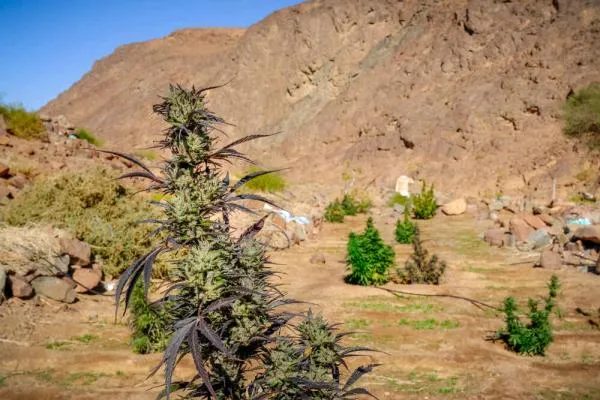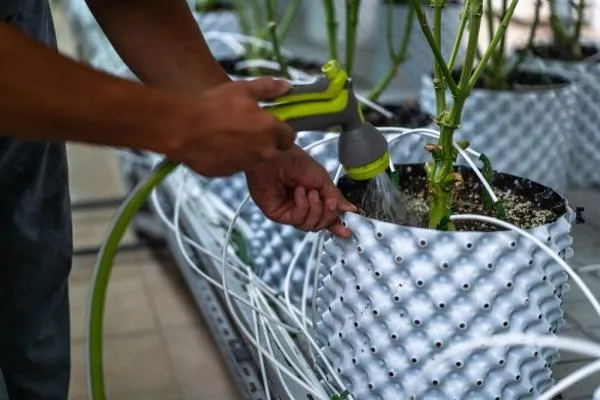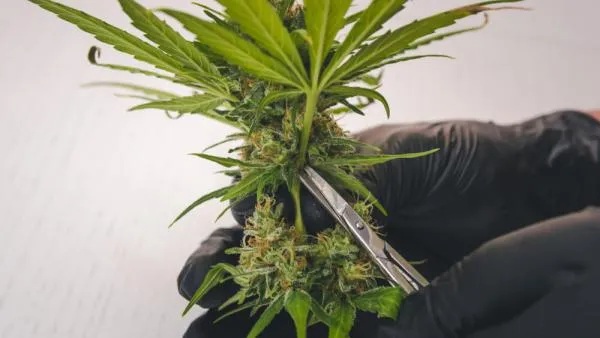Cannabis training techniques come in all shapes and sizes, from simple and straightforward to ridiculously convoluted. ScrOGging is one of the easiest, most productive low stress training methods available, and one of the simplest for budding growers to implement…
What Is ScrOG Growing with Cannabis?
ScrOG. What a weird word. When I first heard it, years ago, I thought it sounded more like the name of one of the alien invaders in an old episode of Star Trek than a term connected to cannabis cultivation. Beware the deadly ScrOG.
It's actually a shortened version of three words smashed together and describes one of the best Low-Stress training techniques for cannabis crops.
What Does ScrOG Stand For?
ScrOG stands for ‘Screen of Green’. It's one of the most straightforward and effective cannabis training techniques, allowing growers to maximize their yields without having to invest too much time or effort into their crop.
Cannabis plants, when left to their own devices, will grow in an Apical form. Think of a classic Christmas tree shape. This structure comes with a range of evolutionary advantages, but it does not lend itself to the most efficient use of available light and resources, which can lead to lower-than-maximum yields.
By simply placing a screen or net of some kind over the top of their cannabis plant, growers are able to manipulate its shape and overall structure in order to encourage heavier yields. This is done by controlling the shape and plane of growth (switching it from vertical to horizontal), which not only encourages a more even distribution of energy-producing resources, growth hormones, and nutrition - but also allows for better light penetration and airflow throughout all of the budding sites.
Does ScrOG Growing Increase Yield?
Yep, it sure does. Or, at least, it can when implemented effectively.
By controlling the way, a marijuana plant grows, we (as the growers) can manipulate the plant into doing things that it never would when growing wild.
As mentioned before, by using a screen or net to limit the way the plant grows vertically, and instead spreading the growth of the branches and main stem horizontally, we can ensure that each and every bud gets the same amount of light, growth hormone, and nutrients, allowing for more efficient growth.
Of course you need to grow with high yielding strains to start with but by taking the reigns and directing how our plants grow, we can create a structure that will be much more receptive to larger yields, and in some cases get close to doubling the harvest of an unmanaged plant.

Why Does ScrOGging Have This Effect?
It's all pretty simple. By changing the plant structure from a top-down dominance into a horizontal growth pattern, we essentially trick the plant into thinking that the main cola (budding site) has been damaged, or even chopped off completely. When this happens, the plant tries to ensure the highest chance of survival and reproduction by boosting the flowering at all the budding, instead of just focusing on the main one.
By using a mesh or screen to train the plant in this way, we can encourage it to focus its energy on the lower branches, pushing out more buds with denser structure and heavier resin production in a shorter amount of time. In addition to this, we can also manipulate the way the plant spreads itself outward, meaning that each and every bud will get an increased degree of light penetration and more airflow through the entire canopy. Pretty much everyone understands how important light is to the successful growth of all plants, but many newer cannabis cultivators overlook the importance of airflow, especially within the structure of the plant itself. Not only does fresh air bring higher levels of oxygen and C02, but it also massively lowers the risk of any mold issues arising, especially in the last few weeks of flower.
It also allows for growth area maximization. The single plane that the canopy grows over allows for more dense packing of plants, allowing producers to make use of the full potential of their growing environment.
Who Is ScrOG Growing Best Suited For?
Honestly, absolutely everybody.
From huge commercial farms to the smallest home-growing setups - ScrOGs can be cheaply, easily, and quickly implemented in almost any cannabis cultivation situation. They work with all styles of growing, from indoor hydro systems to organic outdoor arrangements.
They are the perfect introduction to plant training for novice growers, but also a perfect addition to even the most experienced gardeners' setup. When done right, ScrOG growing can provide some of the best yields, the most potent buds, and a streamlined grow cycle. Just remember to take things slow when you first start out and take the time to plan your setup correctly. The old saying "measure twice, cut once" couldn't be more apt.
When Should You Start ScrOGging Cannabis Plants?
You will want to have your ScrOG setup well in advance if at all possible. The different ways that a ScrOG screen can be set up are almost endless and will depend on the style of cultivation that you are running. But, one thing that doesn't change - no matter the cultivation configuration - is the fact that you want your screen in place before the plants get too big.
Getting that net or screen in early is way easier than having to battle the plant later on and allows for more natural plant development into the screen. This helps in hugely reducing the amount of stress that you put onto the plant, something that will help in keeping it healthy and happy, and on track to produce the best possible yield.
The accepted rule of thumb is to have the screen set up before the plant develops the third or fourth node. This is especially true when growing with autoflowering strains, as they have a limited vegetative growth period (unlike photoperiod plants that can be forced to stay in veg). This makes autos a little more sensitive to the stress that pruning, and training impart on the plant, so having that screen in place before they get too big is key to success.
Hold up, though. There's a fine balance between starting your ScrOG training too early, and too late. The last thing you want to do is to have to change the screen height because the plant it is supporting has grown too large, making the screen a little too low. As different strains grow at different rates and to different heights, there is no one easy answer for when exactly you should start feeding the plant through the net, unless...
You first top your plant.
What's Topping?
Topping cannabis is the act of cutting off the top of the main stem just above one of the nodes and where the new branches are forming. Doing this will give you an idea of how tall your plant will end up, as by removing the top of the main stem you are removing the majority of its upward growth capabilities.
The result? A much more controllable structure, with a massive boost to outward instead of upward growth, and a doubling in the main budding sites each time you top. That's right, photoperiodic plants can be topped multiple times, but its usually not recommended for autos thanks to the lack of vegetative growth time.
For a full rundown of how to top a cannabis plant, and why it makes sense to use both topping and ScrOGging in unison, check out our guide right here.
How To ScrOG Grow
Ok, so we have mentioned that there are a bunch of ways to set up a ScrOG. The exact process will be decided by your specific gardening situation. Where one grower may be able to simply sling a net up and attach it to the poles of their grow tent, others will have to jerry-rig a bunch of DIY single-pot ScrOG nets for each and every plant.
There's also the genetics that you are growing to take into account. A single tall, rangy, long flowering Sativa plants may take up the same space as a bunch of smaller indicas or autos. If you are looking into setting up a screen that will service multiple strains, it's best to either choose cultivars that grow to a similar height or top them at the same level before feeding them through the screen.
If a multiple-plant net is in your plans, always keep in mind that these plants need to be spaced correctly. Novice growers are often surprised by just how much space several plants take up by the time they have reached the midway point of flower production, and its a common problem that the space becomes so cramped that airflow and light penetration is restricted to the point that mold issues raise their ugly head.

ScrOGging A Tent
If you are growing in a tent, simply head to your local hydroponic or hardware supplier (or Amazon) and grab the right-sized net for your tent. You want this net to be just slightly larger than the tent footprint, as this will make installation a bunch easier. You also want to choose a net that has medium-sized openings. you'll struggle to fit the stems and branches through a net with overly tight holes, but you will also struggle to keep your plant tamed if the holes are too large.
Single Pot ScrOGs
Setting up a single-pot ScrOG is relatively easy and can be done in a few ways. If you have access to tomato trellis' then they can work great, but they're not necessary. Single-pot ScrOGs are most commonly used for outdoor plants, but there's no reason you can't play around with them indoors too. You can also buy ready made single pot ScrOG nets such as the one in the image below.
To bang together a quick DIY single-pot ScrOG setup there are just a few things you'll need to grab.
- PVC piping - you want to grab one of the thinner options, around 1/2" to 1",
- 90-degree angle joints to connect the piping together and create a frame for the net
- Zip ties
- Duct or gaffer tape - electrical tape can work also, but it doesn't last as long - especially in outdoor situations.
- Netting, or twine to weave a net round the frame.
- A handsaw to cut the pipe to size
We're not going to go into super in-depth detail on measurements and whatnot, as this will be dictated by the size of the plants, the size of the pot, and the area you are growing in. For the most part, a 1.5 x 1.5-foot frame should be more than big enough for a single plant, but a 1 x 1 foot sizing should also be fine.
The process is simple -
- Cut the pipe into the lengths that suit your situation
- Connect them together with the 90 degree elbow joints to create the frame
- Cut two to four more pipe lengths to use as legs, and tape them in place. Use a little more tape than you may think is needed, better more than less.
- You may want to heat up and flatten the lower half of the legs, which will help with pushing them into the soil.
- Cover the frame with the net, stick it in place, and your golden.

How High Above the Plant Should the ScrOG Net Sit?
That is, again, dependent on the cultivar, and the growing situation. A good general rule is about 30cm above the second node, but that's only really a starting point. If you're aiming to maximize yields, a little more height is better - in this case you'll probably be keeping the plants in veg a little longer, which means they will need more room to develop.
Conclusion
There we go, everything there is to know about ScrOG training.
Perfect for all levels of cultivation ability, and all types of grow situations - ScrOG is one of the most powerful and effective training methods out there. Its ability to maximize yields in constrained spaces makes it a favorite for indoor growers, but its application outside is just as effective.
Remember to combine it with topping for the best results (with photoperiod strains) and keep a close eye on the canopy to ensure it doesn't become an unruly mess. Mold issues are the last thing any grower wants to deal with.










